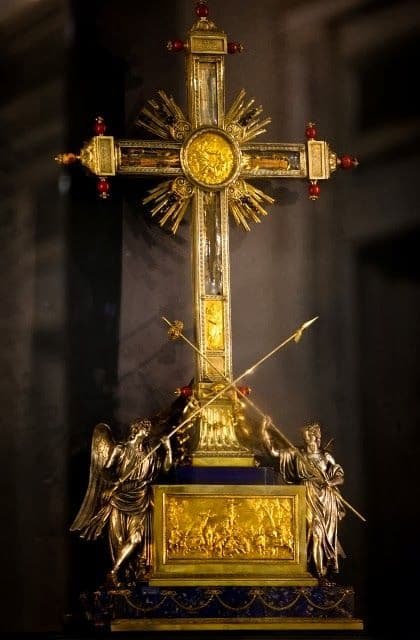In the year 327 the empress, mother of Constantine, was a pilgrim in Jerusalem and wanted to proceed with the search for the Holy Cross. The story tells of the discovery of three crosses in an ancient cistern, together with the nails (one of which is mounted on the Iron Crown at Monza, a second is in Milan Cathedral and the third in Rome) and the titulus, the cartouche - wanted by Pilate - containing the condemnation in three languages (a fragment is in Rome, in the Church of the Holy Cross).
A miracle made it possible to identify the cross of Christ. Legend has it that around 326 Empress Elena of Constantinople (mother of Emperor Constantine I the Great) had the temple of Venus on Calvary in Jerusalem demolished and excavated until news reached her that the True Cross had been found.
The journey was made to find the Holy Sepulchre, which was lost. The search began because of the cult of the cross, since the death of Jesus Christ. According to the Golden Legend of Santiago de la Vorágine, when the empress - then eighty years old - arrived in Jerusalem, she had the wisest Jews in the country interrogated so that they would confess as much as they knew about the place where Christ had been crucified.
After obtaining this information, they took her to the so-called Mount of the Skull (Golgotha), where Emperor Hadrian, 200 years earlier, had ordered a temple to be built dedicated to the goddess Venus. It is believed that Golgotha was in fact an old abandoned quarry with a rocky massif, not very useful for construction, which remained unused and later constituted the scaffold where the Romans placed their crosses.
This quarry was outside the wall, but close to it. Saint Elena ordered the temple to be demolished and excavated in that place, where according to legend she found three crosses: that of Jesus and that of the two thieves. As it was impossible to know which of the three crosses was that of Jesus, legend has it that Helen had a dead man brought in, who, on coming into contact with the cross of Jesus Christ, the True Cross, rose from the dead.
The discovery of the relic was formerly commemorated in the month of May as the Feast of the Invention of the Holy Cross. The Empress and her son Constantine had a magnificent temple built on the site of the discovery, the so-called Basilica of the Holy Sepulchre, in which they kept the relic. Much later, in 614, the Persian King Croesus II took Jerusalem and, after victory, took the True Cross and placed it under his throne as a symbol of his contempt for the religion of the Christians.
After 15 years of fighting, the Byzantine Emperor Heraclius finally defeated him in 628. Shortly afterwards, in a ceremony held on September 14 of that year, the True Cross returned to Jerusalem, carried in person by the emperor through the city in procession. Legend has it that when the emperor, clothed in great magnificence, wanted to carry the relic, he was unable to do so, not being able to do so until he stripped himself of all finery in imitation of the poverty and humility of Christ.
Since then, that day has been marked in the liturgical calendars as the day of the Exaltation of the Holy Cross. The Chapel of St. Helena It is a 12th century Armenian church on the lower level of the Church of the Holy Sepulchre in Jerusalem. In the southeast of the chapel there is a chair that was reputed to be a seat that was used by St. Helen, mother of Emperor Constantine, when she went in search of the True Cross.
There are two apses in the church, one dedicated to St. Helena and the other to Dimas, the repentant thief on the cross. The chapel is modestly decorated in memory of the simplicity of St. Helena. From the ambulatory, a staircase leads down to the chapel dedicated to St. Helena.
The walls of the staircase are covered with crosses, incised in past centuries by Armenian pilgrims to testify to the devotion to the Cross of this people. The chapel with three naves, with 4 columns supporting the dome, is owned by the Armenians and dates back to the 12th century.
Sources and archaeological excavations confirm that already in the Constantine project the hall was used in some way. Many lamps in the Armenian style hang on the walls. From the Armenian Chapel of St. Helena, one can access the lower part of the "Inventio Crucis", where every year, on May 7th, the memory of the discovery of the Holy Cross is celebrated and where the Franciscan Custodian father carries the wooden relic of the Cross of Christ in procession to the point where it was traditionally found.
✠ ✠ ✠ nnDnn ✠ ✠ ✠
Semper Fidelis, In aeternum.
